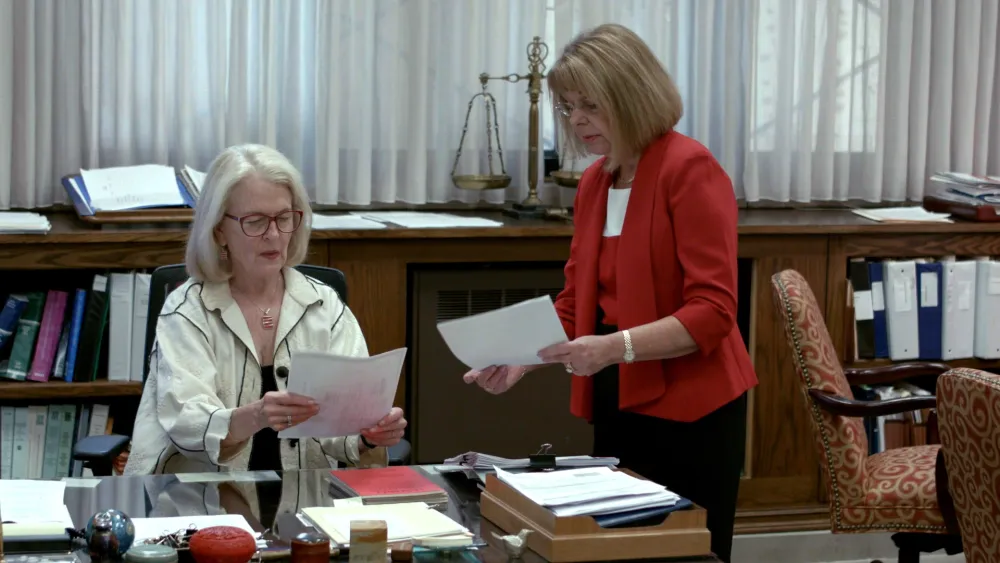
U.S. District Judge Janet Arterton, left, and Clerk of Court Robin Tabora have helped the District of Connecticut summon fewer jurors to the court, reducing costs and public frustration.
Juries play a unique and central role in America’s justice system. But for many prospective jurors who are summoned, federal jury service is anything but exalting. Instead, it can be a long, listless day of waiting, only to be told that the court has more than enough candidates to fill the panel.
In the District of Connecticut, that has changed dramatically. The court has summoned fewer prospective jurors and more effectively engaged those who come to the courthouse. This has been accomplished through fairly simple measures — a campaign to educate its own judges, the implementation of a Jury Committee comprised of judges and Clerk’s Office staff, and training for jury clerks and courtroom deputies.
The result has been a classic win-win, saving many citizens from a wasted day in an assembly room—while cutting costs for courts and taxpayers and ensuring that a rite of citizenship remains a positive experience.
A key, said U.S. District Judge Janet Arterton, Chair of the Jury Committee, has been “recognizing that better jury utilization was going to be not only a cost savings—for the court, the jurors, for their employers—but also it was going to give the message to the jurors that we respected their time.”
The District of Connecticut is by no means unique in seeking to use prospective jurors more efficiently. In 2009, 40 percent of all prospective jurors in U.S. district courts were not selected or challenged by lawyers on their first day at court, a number that dropped to 36.6 percent by 2015.
But Connecticut has gone farther. For the third straight year, less than 20 percent of all prospective jurors have been sent home without being selected or challenged on their first day—a number that dropped as low as 11 percent in 2014. By contrast in 2011, the court was almost identical to the national average, failing to use 37 percent of prospective jurors.
Two changes have sparked most of the improvement. Judges are being asked to trust that they can call fewer eligible jurors, and still be able to fill their panels even after lawyers strike some from the list. In addition to cutting the number of prospective jurors, it speeds the selection process.
“If you have 80-100 prospective jurors being questioned, that can take a long time,” said Clerk of Court Robin Tabora. “When you're calling in 20-30 jurors, you get through it much quicker. And all of the jurors know they need to be here, that each one of them is important.”
Of at least equal importance, said Arterton, judges are working with lawyers to identify firm trial dates before a jury summons is mailed to prospective jurors. This enables those with scheduling conflicts to notify the court in advance by email, thus avoiding the drive to the courthouse and sitting for hours to request to be excused.
The changes have required getting buy-in from judges, who need enough potential jurors to be able to select a panel. Rhonda “Ronnie” Vermette, the court’s jury administrator, says court jury staff and courtroom deputies help reassure judges by researching comparable cases.
“We’ll look at a similar case from a few months prior, and remind the judges how many jurors were brought in, and how many weren’t used,” Vermette said. “We’ll then suggest that they summon fewer jurors for the current case. The judges actually are getting more comfortable summoning fewer jurors.”
Court officials also have focused on improving the juror experience. To give jurors a sense of involvement, Tabora said, the court makes a point of bringing all jurors into the courtroom for voir dire, even if more prospective jurors report than necessary. In addition, light refreshments, such as coffee, pastry, and healthy snacks are made available during trial breaks, and court staff are quick to explain unexpected delays.
And Judge Michael Shea, also a member of the Jury Committee, says he and the other judges meet with jurors after the conclusion of the trial, so that jurors can ask questions about the proceedings and provide feedback about their experience. “Most of them find that very valuable,” he said.
The District also has partnered with the Connecticut Business and Industry Association, known as the “voice” of business in Connecticut, to record public service announcements, including interviews with jurors who recently served and the jury administrator. In addition to touting the value of jury service, they encourage companies to support employees, noting that it is against the law to discharge, intimidate, threaten, or coerce any permanent employee because of federal jury service.
Federal jurors, including those not called to serve, are paid $40 a day, so reducing jury pools also saves money. In the twelve months ending June 2015, for instance, the Judiciary reported national savings of $412,261 in jury-related costs, by reducing the number of unutilized jurors by 4,797 from the previous year.
But District of Connecticut officials say the gains to the court, and the public, are not just monetary.
“This isn't about just impressing the public,” said Shea. “Ensuring a positive experience for jurors ultimately benefits the litigants because jurors who don't believe their time is being wasted, jurors who are interested in the process and participate with enthusiasm and vigor, are jurors who can ensure litigants a fair trial.”
Subscribe to News Updates
Subscribe to be notified when the news section is updated.
